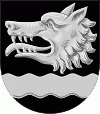Sipoo
 |
The coat of arms of the municipality refers to the origin story of the settlement, according to which the ancestors of Sipoo are said to have arrived in the region on a viking ship, the bow of which was decorated with a head of wolf; accordingly, locals have even been called the “wolves of Sipoo”. The wave lined fess of the coat of arms refers to the Sipoo River.
It is the eastern neighbour of Helsinki and western neighbour of Porvoo, located in the Uusimaa region. Other neighboring municipalities are Vantaa, Kerava, Tuusula, Järvenpää, Mäntsälä and Pornainen. There are two important road connections in the direction of Helsinki from Sipoo: Highway 7, known as the Porvoo Highway (part of E18), and Road 170, which is known as the Itäväylä on the Helsinki side.
The once almost completely Swedish-speaking municipality is bilingual since 1953, a majority being Finnish speakers, due to migration from other parts of Finland since 2003. Today the Finnish-speaking majority stands at 0 and the Swedish-speaking minority is about 0 of the population.
On June 26, 2006, the Sipoo town council decided on a strategy to triple the municipality's population over the next 25 years. The decision was made after Helsinki announced plans to annex a part of the municipality in order to continue to build high-end urbanizations by the coastline (and thus high-tax revenue producing). The Finnish Council of State voted in favor of the annexation on June 28, 2007, with votes 8 to 4. Sipoo appealed to the Supreme Administrative Court, but the court upheld the decision of the Council of State and the annexation took place on January 1, 2009. As Helsinki did not directly border Sipoo at any point, the city of Vantaa ceded the area lain between Helsinki and Sipoo to Helsinki in the process.
Map - Sipoo
Map
Country - Finland
 |
 |
| Flag of Finland | |
Finland was first inhabited around 9000 BC after the Last Glacial Period. The Stone Age introduced several different ceramic styles and cultures. The Bronze Age and Iron Age were characterized by contacts with other cultures in Fennoscandia and the Baltic region. From the late 13th century, Finland became a part of Sweden as a consequence of the Northern Crusades. In 1809, as a result of the Finnish War, Finland became part of the Russian Empire as the autonomous Grand Duchy of Finland, during which Finnish art flourished and the idea of independence began to take hold. In 1906, Finland became the first European state to grant universal suffrage, and the first in the world to give all adult citizens the right to run for public office. After the 1917 Russian Revolution, Finland declared independence from Russia. In 1918, the fledgling state was divided by the Finnish Civil War. During World War II, Finland fought the Soviet Union in the Winter War and the Continuation War, and Nazi Germany in the Lapland War. It subsequently lost parts of its territory, but maintained its independence.
Currency / Language
| ISO | Currency | Symbol | Significant figures |
|---|---|---|---|
| EUR | Euro | € | 2 |
| ISO | Language |
|---|---|
| FI | Finnish language |
| SV | Swedish language |















